Born 8 Oct 1951; died 10 Aug 2021 at age 69.
Japanese puzzlemaker was known as the “Father of Sudoku” for coining the name under which he popularized that puzzle. In 1980, Kaji with two childhood friends began publishing Nikoli, in Japan as a quarterly puzzle magazine, which included Sudoku puzzles after he came across the game in 1984 under the title “Number Place,” created by American architect Howard S. Garns, first published in Dell Pencil Puzzles and Word Games (May 1979). It is played by filling the cells in a 9x9 grid with numbers 1 to 9 in such a way that each appears only once in each column, row or the nine 3x3 sections which make the full grid. Kaji founded the Nikoli company in 1983 for the magazine and other puzzle games.«
Japanese puzzlemaker was known as the “Father of Sudoku” for coining the name under which he popularized that puzzle. In 1980, Kaji with two childhood friends began publishing Nikoli, in Japan as a quarterly puzzle magazine, which included Sudoku puzzles after he came across the game in 1984 under the title “Number Place,” created by American architect Howard S. Garns, first published in Dell Pencil Puzzles and Word Games (May 1979). It is played by filling the cells in a 9x9 grid with numbers 1 to 9 in such a way that each appears only once in each column, row or the nine 3x3 sections which make the full grid. Kaji founded the Nikoli company in 1983 for the magazine and other puzzle games.«
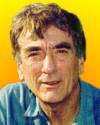
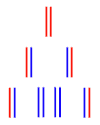
Franklin William Stahl is an American geneticist, who, in 1958, (with Matthew Meselson) devised a way to study the Crick and Watson replication hypothesis for DNA (1958) as a double-stranded helix molecule that separates into two strands, each reproducing the original pattern with two new helices. To trace the original strands, those DNA molecules were tagged with a heavier nitrogen isotope. They grew E. coli bacteria on a nutrient treated to contain nitrogen-15. Thus their DNA became heavy. They switched the E. coli onto untreated media with common nitrogen-14. They analyzed the DNA after each generation. After one generation, all of the DNA was medium-weight. Thus one strand of the double helix was heavy and one strand was light. After two generations, half of the DNA was medium-weight and half was normal light-weight DNA.«In the diagram, at the top, the original DNA strands are both shown in red as tagged for N-15. The next generation (middle) reconstitutes with one strand each of ordinary N-14 (blue). At the bottom is shown the strand pairing for the following generation.
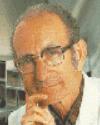
Born 8 Oct 1927; died 24 Mar 2002 at age 74. quotes
Argentinian immunologist and molecular biologist who shared the 1984 Nobel Prize for Physiology or Medicine (with Georges Köhler and Niels K. Jerne) for “theories concerning ... the immune system and the discovery of the principle for production of monoclonal antibodies” (proteins produced by the cells of the immune system). He derived an immortal cell hybrid from antibody-producing B lymphocyte cells and tumour cells. This “hybridoma,”could continuously synthesize antibodies which were identical (monoclonal), to those produced by the original B cell. This technique of monoclonal antibody production, developed (1975) with Köhler, has enabled wide commercial development of new drugs and diagnostic tests.«
Argentinian immunologist and molecular biologist who shared the 1984 Nobel Prize for Physiology or Medicine (with Georges Köhler and Niels K. Jerne) for “theories concerning ... the immune system and the discovery of the principle for production of monoclonal antibodies” (proteins produced by the cells of the immune system). He derived an immortal cell hybrid from antibody-producing B lymphocyte cells and tumour cells. This “hybridoma,”could continuously synthesize antibodies which were identical (monoclonal), to those produced by the original B cell. This technique of monoclonal antibody production, developed (1975) with Köhler, has enabled wide commercial development of new drugs and diagnostic tests.«
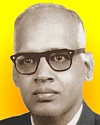
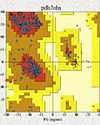
Ramachandran plot
Gopalasamudram Narayanan Ramachandran was an Indian biophysicist who discovered the triple helical “coiled coil” structure of the collagen molecule, among other remarkable contributions to structural biology. Ramachandran was a master of X-ray crystallography, and with his colleagues, he constructed space filling models of protein molecules. He devised the Ramachandran Plot, a method to diagram the conformation of polypeptides, polysaccharides and polynucleotides. It remains the international standard to describe protein structures. Ramachandran also explored artificial intelligence (AI), inspired by the ancient Syaad Nyaaya (doctrine of may be). He developed the Boolean Vector Matrix Formulation which has important application in writing software for AI.«
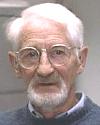
Born 8 Oct 1918.
Danish biophysicist who (with Paul D. Boyer and John E. Walker) was awarded the Nobel Prize for Chemistry in 1997 for his discovery of the enzyme called sodium-potassium-activated adenosine triphosphatase (Na+-K+ ATPase). This enzyme, which is found in the plasma membrane of animal cells, maintains the balance of sodium and potassium ions in the living cell. Skou used as experimental material finely ground crab nerve membranes. The enzyme pumps sodium out of the cell and potassium into it, thereby maintaining a high intracellular concentration of potassium and a low concentration of sodium relative to the surrounding external environment. He was first to identify an enzyme that moves substances through cell membranes, a key function of all cells.
Danish biophysicist who (with Paul D. Boyer and John E. Walker) was awarded the Nobel Prize for Chemistry in 1997 for his discovery of the enzyme called sodium-potassium-activated adenosine triphosphatase (Na+-K+ ATPase). This enzyme, which is found in the plasma membrane of animal cells, maintains the balance of sodium and potassium ions in the living cell. Skou used as experimental material finely ground crab nerve membranes. The enzyme pumps sodium out of the cell and potassium into it, thereby maintaining a high intracellular concentration of potassium and a low concentration of sodium relative to the surrounding external environment. He was first to identify an enzyme that moves substances through cell membranes, a key function of all cells.
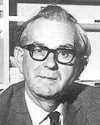
Born 8 Oct 1917; died 7 Sep 1985 at age 67.
British biochemist who (with Gerald M. Edelman) was awarded the 1972 Nobel Prize in Physiology or Medicine for discoveries concerning the chemical structure of antibodies. As giant molecules, antibodies are difficult to study. Both scientists looked for methods to split the large molecules into well defined fragments that, it was hoped, would prove to be more easily handled. Porter found that this could be done using papain, a protein splitting enzyme. Whereas previously it had earlier been assured that the most common type of antibody would carry two identical combining sites, Porter in fact found that the molecule split into three fragments: two smaller very similar ones, both with capacity of combining with the antigen, and one larger one lacking this capacity. He died in a car accident.
British biochemist who (with Gerald M. Edelman) was awarded the 1972 Nobel Prize in Physiology or Medicine for discoveries concerning the chemical structure of antibodies. As giant molecules, antibodies are difficult to study. Both scientists looked for methods to split the large molecules into well defined fragments that, it was hoped, would prove to be more easily handled. Porter found that this could be done using papain, a protein splitting enzyme. Whereas previously it had earlier been assured that the most common type of antibody would carry two identical combining sites, Porter in fact found that the molecule split into three fragments: two smaller very similar ones, both with capacity of combining with the antigen, and one larger one lacking this capacity. He died in a car accident.
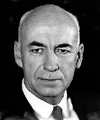
Born 8 Oct 1913; died 17 Aug 2000 at age 86.
American aerospace scientist, engineer, and a pioneer of the Mercury, Gemini, and Apollo space programs. He developed the X-1, first plane to break the sound barrier. Gilruth directed Project Mercury, the initial program for achieving manned space flight. Under his leadership, the first American astronaut orbited the Earth only a little over 3 years after NASA was created. In 1961, President Kennedy and the Congress committed the nation to a manned lunar landing within the decade. Gilruth was named the Director of the Manned Spacecraft Center and assigned the responsibility of designing and developing the spacecraft and associated equipment, planning and controlling missions, and training flight crews. He retired from NASA in 1973.
American aerospace scientist, engineer, and a pioneer of the Mercury, Gemini, and Apollo space programs. He developed the X-1, first plane to break the sound barrier. Gilruth directed Project Mercury, the initial program for achieving manned space flight. Under his leadership, the first American astronaut orbited the Earth only a little over 3 years after NASA was created. In 1961, President Kennedy and the Congress committed the nation to a manned lunar landing within the decade. Gilruth was named the Director of the Manned Spacecraft Center and assigned the responsibility of designing and developing the spacecraft and associated equipment, planning and controlling missions, and training flight crews. He retired from NASA in 1973.
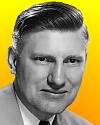
1950
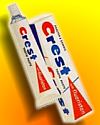
Harry Gilbert Day was an American nutritional biochemist who helped develop (with Joe Muhler and William Nebergall) the fluoride additive used in toothpaste to combat tooth decay. Proctor and Gamble (P&G) funded his research at Indiana University. In 1955, the Food and Drug administration approved stannous fluoride for use in toothpaste. P&G introduced Crest toothpaste in Jan 1956 with this ingredient, which they called fluoristan. The patent was held by Indiana University, and P&G paid royalties for its use. In his career, Day's research evaluated the health aspects of food ingredients, principles of food safety, and nutrition including the nutritional requirements of phosphorus, zinc, fluoride, boron and iron. «
Born 8 Oct 1901.
Australian physicist.
Australian physicist.
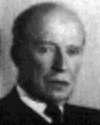
Born 8 Oct 1888; died 8 Feb 1964 at age 75. quotes
German psychiatrist who attempted to correlate body build and physical constitution with personality characteristics and mental illness. Kretschmer analyzed over 4,000 criminal cases using his 3 body type model: (1) leptosome or asthenic [tall and thin], (2) athletic [well developed muscles], and (3) pyknic [short and fat]. His conclusion was that were is a greater number of violent criminals who correspond to the athletic type, while the asthenic are more likely to be involved in petty theft and fraud. Finally, Kretschmer found that the pyknic tended toward crimes involving deception and fraud but were also sometimes involved in violent crimes.
German psychiatrist who attempted to correlate body build and physical constitution with personality characteristics and mental illness. Kretschmer analyzed over 4,000 criminal cases using his 3 body type model: (1) leptosome or asthenic [tall and thin], (2) athletic [well developed muscles], and (3) pyknic [short and fat]. His conclusion was that were is a greater number of violent criminals who correspond to the athletic type, while the asthenic are more likely to be involved in petty theft and fraud. Finally, Kretschmer found that the pyknic tended toward crimes involving deception and fraud but were also sometimes involved in violent crimes.
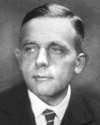
Born 8 Oct 1883; died 1 Aug 1970 at age 86.
Otto Heinrich Warburg was a German biochemist awarded the Nobel Prize for Physiology or Medicine in 1931 for his research on cellular respiration, the process by which substances directly supplied to cells or stored in them are broken down into simpler components while using up oxygen. It is by this process that the energy required for other vital processes is made available to the cells in a form capable of immediate utilization. He devised a manometer for this research, enabling him to study the action of respiratory enzymes and poisons in detail.
Otto Heinrich Warburg was a German biochemist awarded the Nobel Prize for Physiology or Medicine in 1931 for his research on cellular respiration, the process by which substances directly supplied to cells or stored in them are broken down into simpler components while using up oxygen. It is by this process that the energy required for other vital processes is made available to the cells in a form capable of immediate utilization. He devised a manometer for this research, enabling him to study the action of respiratory enzymes and poisons in detail.
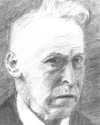
Born 8 Oct 1873; died 21 Oct 1967 at age 94. quotes
Danish astronomer who classified types of stars by relating their surface temperature (or colour) to their absolute brightness. A few years later Henry Russell illustrated this relationship graphically in what is now known as the Hertzsprung-Russell diagram, which has become fundamental to the study of stellar evolution. In 1913 he established the luminosity scale of Cepheid variable stars.
Danish astronomer who classified types of stars by relating their surface temperature (or colour) to their absolute brightness. A few years later Henry Russell illustrated this relationship graphically in what is now known as the Hertzsprung-Russell diagram, which has become fundamental to the study of stellar evolution. In 1913 he established the luminosity scale of Cepheid variable stars.
Born 8 Oct 1872; died 1948.
(a.k.a. Christine Bonnevie) Norwegian zoologist and geneticist who in 1911 became the first woman admitted to the Norwegian Academy of Science and Letters. In 1912, the University of Oslo was appointed her as Norway's first female professor. One of her students in the 1930's was Thor Heyerdahl who later organized and led the famous Kon-Tiki (1947) and Ra (1969-70) transoceanic scientific expeditions.
(a.k.a. Christine Bonnevie) Norwegian zoologist and geneticist who in 1911 became the first woman admitted to the Norwegian Academy of Science and Letters. In 1912, the University of Oslo was appointed her as Norway's first female professor. One of her students in the 1930's was Thor Heyerdahl who later organized and led the famous Kon-Tiki (1947) and Ra (1969-70) transoceanic scientific expeditions.
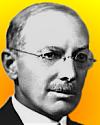
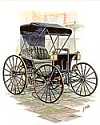
Duryea 1893
James Frank Duryea was an American inventor who with his brother Charles Duryea built the first automobile with multiple copies manufactured in the U.S. On 28 Nov 1895, Frank drove their car to win first prize in the first American Automobile Race in Chicago, held by the Chicago Times-Herald. At 8:55 am, six “motocycles” left Chicago’s Jackson Park for a 54 mile race to Evanston, Illinois and back through the snow. Duryeas’ No.5 took just over 10 hr (ave. 7.3 mph). Early in 1896, the Duryeas manufactured 13 copies of the car. Frank developed the “Stevens-Duryea,” an expensive limousine, which remained in production into the 1920s. The brothers are recognised as “Fathers of the American Automobile Industry.”« more
Charles E. Duryea: Automaker, by George W. May. - book suggestion.
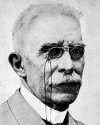
Born 8 Oct 1850; died 17 Sep 1936 at age 85.
French chemist who is best known for the principle of Le Chatelier, which makes it possible to predict the effect a change of conditions (temperature, pressure, and concentration of reaction components) will have on a chemical reaction. This principle proved invaluable in the chemical industry for developing the most efficient chemical processes. Fritz Haber successfully utilized it in his process for the production of ammonia. Le Chatelier's interests began in metallurgy, cements, ceramics, and glass, and his studies of flames led him to study heat and its measurement. Of several contributions to thermometry, his most important was the first successful design of a platinum and rhodium thermocouple for measuring high temperatures (1887).
French chemist who is best known for the principle of Le Chatelier, which makes it possible to predict the effect a change of conditions (temperature, pressure, and concentration of reaction components) will have on a chemical reaction. This principle proved invaluable in the chemical industry for developing the most efficient chemical processes. Fritz Haber successfully utilized it in his process for the production of ammonia. Le Chatelier's interests began in metallurgy, cements, ceramics, and glass, and his studies of flames led him to study heat and its measurement. Of several contributions to thermometry, his most important was the first successful design of a platinum and rhodium thermocouple for measuring high temperatures (1887).
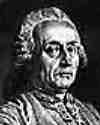
Born 8 Oct 1708; died 27 Feb 1794 at age 85. quotes
Jean-Rodolphe Perronet was a French civil engineer who was renowned for his stone-arch bridges, especially the Pont de la Concorde, Paris. During construction of a bridge at Mantes in 1763, Perronet made the discovery that the horizontal thrust of a series of elliptical arches was passed along to the abutments at the ends of the bridge. Thus he was able to build extremely flat arches that were supported during construction by timbering (falsework) and mounted on very slender piers, which widened the waterway for navigation and reduced scour from the current.
Jean-Rodolphe Perronet was a French civil engineer who was renowned for his stone-arch bridges, especially the Pont de la Concorde, Paris. During construction of a bridge at Mantes in 1763, Perronet made the discovery that the horizontal thrust of a series of elliptical arches was passed along to the abutments at the ends of the bridge. Thus he was able to build extremely flat arches that were supported during construction by timbering (falsework) and mounted on very slender piers, which widened the waterway for navigation and reduced scour from the current.
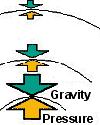
Died 8 Oct 1940 at age 78 (born 4 Mar 1862).
Swiss astrophysicist and mathematician who wrote Gaskugeln (Gas Spheres, 1907), giving a mathematical model of stellar structure as the expansion and compression of gas spheres, wherein the forces of gravity and gas pressure are in equilibrium. He expanded on earlier work by J. H. Lane (1869) and A. Ritter (1878-83) who first derived equations describing stars as gaseous chemical, spherical bodies held together by their own gravity and obeying the known gas laws of thermodynamics. For four decades, the Lane-Emden equation was the foundation of theoretical work on the structure of stars: their central temperatures and pressures, masses, and equilibria. Emden also devised a hypothesis, no longer taken seriously, to explain sunspots.«
Swiss astrophysicist and mathematician who wrote Gaskugeln (Gas Spheres, 1907), giving a mathematical model of stellar structure as the expansion and compression of gas spheres, wherein the forces of gravity and gas pressure are in equilibrium. He expanded on earlier work by J. H. Lane (1869) and A. Ritter (1878-83) who first derived equations describing stars as gaseous chemical, spherical bodies held together by their own gravity and obeying the known gas laws of thermodynamics. For four decades, the Lane-Emden equation was the foundation of theoretical work on the structure of stars: their central temperatures and pressures, masses, and equilibria. Emden also devised a hypothesis, no longer taken seriously, to explain sunspots.«
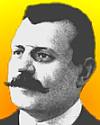
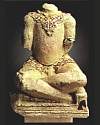
French archaeologist who was an authority on Gallo-Roman and Celtic coins. He wrote Le Manuel d'archéologie préhistorique, celtique et gallo-romaine (1908-14) about the pre-history of France. With his uncle, J.-G. Bulliot, Déchelette excavated Gallic ruins of Bibracte at Mont Beuvray, the only oppidum (a fortified city) in Gaul where the excavations have been sufficiently extended to give an idea of what a Gallic fortified city looked like in the first century B.C. He described his findings in L'Oppidum de Bibracte (1903) which retraces the history of this oppidum and describes what the organisation of the city was: the craft area, the residential area (druids and knights' houses), the place of worship and the wide market place.[Image right: Beuvray relic (source) ]
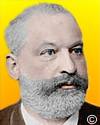
Died 8 Oct 1904 at age 65 (born 26 Dec 1838). quotes
German chemist who discovered the element germanium (1886). He had a background in managing a cobalt glassworks and then on the faculty of the Freiberg School of Mining. Early in his career, he developed new techniques for industrial gas analysis and developed the Winkler gas burette. When, having been asked by the Freiberg Academy of Mining to analyze the mineral argyrodite (a silver sulphide ore), he found that all the known elements it contained amounted to only 93% of its weight. After spending four months tracking down and isolating the remaining 7%, he found the new element he called germanium, for Germany. This turned out to be the third of the elements (eka-silicon) predicted by Dmitry I. Mendeleyev in 1871.« more
German chemist who discovered the element germanium (1886). He had a background in managing a cobalt glassworks and then on the faculty of the Freiberg School of Mining. Early in his career, he developed new techniques for industrial gas analysis and developed the Winkler gas burette. When, having been asked by the Freiberg Academy of Mining to analyze the mineral argyrodite (a silver sulphide ore), he found that all the known elements it contained amounted to only 93% of its weight. After spending four months tracking down and isolating the remaining 7%, he found the new element he called germanium, for Germany. This turned out to be the third of the elements (eka-silicon) predicted by Dmitry I. Mendeleyev in 1871.« more
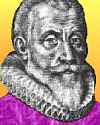
Died 8 Oct 1647 at age 85 (born 4 Oct 1562).
Byname of Christian Severin, a Danish astronomer and astrologer who is best known for his association with, and published support for, Tycho Brahe. He became the first professor of astronomy at the University of Copenhagen, and in 1610 he received funds for instruments and he probably constructed a small observatory at his home. Longomontanus used Tycho's data to compile the Astronomia danica (1622), an exposition of the Tychonic system, which holds that the Sun revolves around the Earth and the other planets revolve around the Sun. He began the construction of the Copenhagen Observatory in 1632, but died before its completion.
Byname of Christian Severin, a Danish astronomer and astrologer who is best known for his association with, and published support for, Tycho Brahe. He became the first professor of astronomy at the University of Copenhagen, and in 1610 he received funds for instruments and he probably constructed a small observatory at his home. Longomontanus used Tycho's data to compile the Astronomia danica (1622), an exposition of the Tychonic system, which holds that the Sun revolves around the Earth and the other planets revolve around the Sun. He began the construction of the Copenhagen Observatory in 1632, but died before its completion.
In 2006, North Korea announced that it had made its first nuclear test, making it the eighth country to explode a nuclear device. The U.S. Geological Survey detected a 4.2 magnitude tremor in North Hamgyong Province. Two days earlier, the United Nations Security Council had warned against making any nuclear test. Afterwards, China said it “firmly opposes” North Korea’s conduct, and that the test was a “flagrant and branzen” violation of international opinion. Satellite intelligence had for several years surveyed for suspected underground test sites. There had been of four decades of that country’s nuclear development efforts leading up to the test explosion.«

In 1965, the Post Office Tower was operationally opened as a telecommunications tower in London, England, for TV and radio broadcasting and to carry all of the microwave traffic into and out of the city. It was then the tallest building in London, until eclipsed by the NatWest Tower (1981). The Prime Minister, Harold Wilson, made an inaugural telephone call to the Lord Mayor of Birmingham, later unveiled a plaque near the foot of the Tower and then rode in a lift to the restaurant floor for a view of London 540 feet below. Now operated by British Telecom instead of the Post Office, the building is renamed the BT Tower. It was designed by G.R.Yeats and is 620ft (189m) to the aerial tip. The lower part of the Tower houses transmitting apparatus.
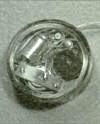
In 1958, Dr Åke Senning implanted the first internal heart pacemaker. Earlier the same year, Rune Elmqvist (born in 1906) invented this pacemaker, designed to be implanted in a subcutaneous pouch in a patient suffering a cardiac disease. It used only two transistors and was the size of a hockey puck. The apparatus sent pulses to the cardiac muscle to establish normal and regular contractions. Dr. Senning (born in 1915) carried out the first pacemaker installation at the Karolinska Institute of Stockholm. Although this prototype worked for only three hours, the Swedish man, Arne Larsson, who received this pacemaker, 40 years and 26 pacemakers later was still enjoying a full, normal life at age 83.
In 1941, a report was written about possible applications of electromechanical calculation to large commercial data-processing needs. In particular, Edmund C. Berkeley was considering the needs of insurance company calculations. He was an actuary at the Prudential Insurance Company. He had in mind the potential usefulness of George Stibitz's Complex Number Calculator. The Prudential Mutual Assurance, Investment and Loan Association, founded 30 May 1848, was the first of the great industrial life insurance companies that eventually was handling the insurance policies of millions of people, but at first had only human computers (i.e., manual methods) to handle them. By 1877, 300 clerks were reviewing 2,500,000 policies were assisted by 24 Thomas de Colmar arithometers. Stibitz was a research mathematician at Bell Telephone Labs whose Complex Number calculator was operation on 8 Jan 1940.«
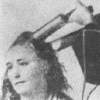
In 1906, a German, Karl Ludwig Nessler, demonstrated the first “permanent wave” for hair, in his beauty salon in Oxford Street, London, to an invited audience of hair stylists. The hair was soaked with an alkaline solution and rolled on metal rods which were then heated strongly. However, this method had the disadvantages of being very lengthy (about 5 hours) and expensive for each application. Also the machine was large and cumbersome, and the client was obliged to wear a dozen brass curlers, each weighing 1-3/4 lb. With the outbreak of WW I, he moved to the United States and opened salons in New York, Chicago, Detroit, Palm Beach and Philadelphia with a peak of 500 employees.
In 1860, a telegraph line between Los Angeles and San Francisco was opened.
Wedding of the Waters: The Erie Canal and the Making of a Great Nation, by Peter L. Bernstein. - book suggestion.
In 1806, Congreve rockets were first used as destructive war implements at Boulogne, when they set the town on fire. Earlier in 1806, they been demonstrated in England in the presence of Mr. Pitt and several of the cabinet ministers. These carcase-rockets had been invented by Sir William Congreve about 1803. Improved rockets were made by Hales in 1846. Boxer's life-saving rope-carrying rockets, for communicating with stranded vessels were described in 1878.*

In 1604, the supernova now called “Kepler's nova” was first sighted in the constellation Ophiuchus, the Serpent Bearer. Johannes Kepler observed it from the time of its appearance as an apparently new star. It encouraged him to write The New Star in 1606.
Johannes Kepler And the New Astronomy, by James R. Voelkel. - book suggestion.




